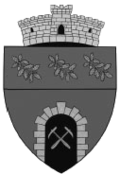Băița (Hunedoara)
|
Băița Pernseifen Boica |
||||
|
||||
| Basic data | ||||
|---|---|---|---|---|
| State : |
|
|||
| Historical region : | Transylvania | |||
| Circle : | Hunedoara | |||
| Coordinates : | 46 ° 2 ' N , 22 ° 54' E | |||
| Time zone : | EET ( UTC +2) | |||
| Height : | 283 m | |||
| Area : | 111.40 km² | |||
| Residents : | 3,712 (October 20, 2011) | |||
| Population density : | 33 inhabitants per km² | |||
| Postal code : | 334075 | |||
| Telephone code : | (+40) 02 54 | |||
| License plate : | HD | |||
| Structure and administration (as of 2016) | ||||
| Community type : | local community | |||
| Structure : | Băița, Barbura , Căinelul de Sus , Crăciuneşti , Fizeş , Hărțăgani , Lunca , Ormindea , Peştera , Sălişte , Trestia | |||
| Mayor : | Damian Diniș ( PSD ) | |||
| Postal address : | Str. Principală, no. 110 loc. Băița, jud. Hunedoara, RO-334075 |
|||
| Website : | ||||
Băița [ ˈbəitza ] (outdated Boița ; German Pernseifen , Hungarian Boica ) is a municipality in the Hunedoara district in Transylvania , Romania .
Băița is also known by the Hungarian names Medvepataka and Kisbánya .
Geographical location
The municipality of Băița is located in southwestern Transylvania, in the southern foothills of the Transylvanian Ore Mountains ( Munții Metaliferi ). Located on the county road ( drum județean ) DJ 706A, the place is about 23 kilometers south of the small town of Brad ( Tannenhof ) and about 25 kilometers north of the district capital Deva ( Diemrich ).
history
The history of settlement in the region goes back to the Bronze Age ; Corresponding objects were discovered in an archaeological site of the incorporated village of Crăciuneşti , on an area called “Măgura” (la Șuri) by the locals . On the territory of Băița, according to reports by G. Téglás, JM Ackner , C. Gooss, V. Christescu, among other things, gold mines, gold washing plants and several finds have been made during archaeological excavations, which point to Roman times .
The place Băița was first mentioned in 1364 under the name Bulzzy .
In the years 1941–1943 there was a camp - "Camp No. 9 - Crăciuneşti" - of the Romanian armed forces in the Romanian Kingdom in the area of the incorporated village of Crăciuneşti . Here were Soviet soldiers. According to contemporary witnesses, it was one of the cruellest camps for Soviet prisoners of war; these were involved in the construction of the now disused railway line Deva-Brad .
The former gold and silver mines as well as the lead, zinc and copper mines of the municipality are closed today. The main occupations of the population are limestone mining , cattle breeding and wood processing.
population
The population of the municipality developed as follows:
| census | Ethnic composition | |||||||
|---|---|---|---|---|---|---|---|---|
| year | population | Romanians | Hungary | German | other | |||
| 1850 | 6,278 | 5,594 | 56 | 538 | 90 | |||
| 1900 | 9.432 | 8,293 | 352 | 704 | 83 | |||
| 1941 | 7,822 | 7,596 | 42 | 157 | 27 | |||
| 1992 | 4,720 | 4,644 | 21st | 28 | 27 | |||
| 2002 | 4,218 | 4.175 | 22nd | 15th | 6th | |||
| 2011 | 3.712 | 3,614 | 14th | 4th | 80 | |||
Since 1850, the highest number of inhabitants - also that of Hungarians - was recorded in 1900 in the area of today's municipality. The highest population of Romanians (8,305) was registered in 1910, that of Germans (713) in 1890 and that of Roma (88) in 1850. In addition, one Ukrainian was registered in 1890, 1956 and 1977, two Ukrainians in 1966 , one Serb in 1956 , four in 1880 and 1966, three in 1900 and 1956, two in 1890 and one Slovak in 2002 .
Attractions
- The Romanian Orthodox wooden church Buna Vestire , built in 1727, is a listed building.
- The Roman Catholic Church in Băița
- The memorial to the local victims of the 1848 revolution
- The church Buna Vestire , built in 1674 in the incorporated village of Trestia ( Rohrbach ), and the wooden church Buna Vestire , built at the end of the 18th century in the incorporated village of Hărțăgani (ung. Hercegány ), are listed monuments.
Personalities
- Mircea Sântimbreanu (1926–1999), writer
Web links
Individual evidence
- ↑ 2011 census in Romania at citypopulation.de
- ^ Dictionary of the localities in Transylvania
- ↑ Heinz Heltmann, Gustav Servatius (Ed.): Travel Guide Siebenbürgen. Kraft, Würzburg 1993, ISBN 3-8083-2019-2 .
- ↑ a b c List of historical monuments of the Romanian Ministry of Culture, updated 2010 (PDF; 7.10 MB)
- ^ Institute Of Archeology - Băița, accessed December 14, 2010 (Romanian)
- ↑ a b Web presentation of the municipality of Băița ( Memento of the original from April 19, 2012 in the Internet Archive ) Info: The archive link was inserted automatically and has not yet been checked. Please check the original and archive link according to the instructions and then remove this notice.
- ^ The Crăciuneşti prison camp , testimony of a contemporary witness on www.evz.ro, from February 14, 2008, accessed on December 12, 2010 (Romanian)
- ↑ Census, last updated November 2, 2008, p. 46 (Hungarian; PDF; 1.1 MB)


